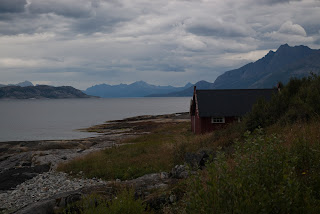 |
| Trolls welcoming us to the highway |
Perhaps the most famous road in Norway and perhaps in all of Scandinavia is Trollstigen (or the Troll Highway). We experienced this fabulous drive as we traveled between Loen on the Innvikfjord to Molde near the coast on the Moldefjord. After breakfast we boarded our bus for a nice drive through this rural part of Norway until we reached Geiranger Fjord where we joined a ferry for a couple of beautiful hours.
Extra beauty was provided by the Seven Sisters Waterfalls. Legend has it that the ladies are being courted by the male falls on the other side. Unfortunately for him they aren’t terribly interested in his ministrations.
At the town of Geiranger, we left the ferry for the Troll Staircase. We began with a climb out the fjord up a narrow road with 13 switchbacks. As spectacular as this drive is, it is not the Troll Staircase. About an hour later we reach the small town of Eidsdal to catch a short ferry across Norddals Fjord to Linde and up the Golden Route to the top of the Troll Staircase where we stopped for lunch. A new museum and cafe are being built to accommodate the growing number of tourists. They have already completed an extensive set of walkways and viewing platforms offering a variety of views of the Staircase and the Stigfossen waterfall across the valley.
 |
| Perhaps you can count all thirteen switchbacks |
 |
| Geiranger is a popular stop for cruise ships |
Riding in a bus up or down these narrow switch-backed roads is not for the faint-hearted. Our 41 foot bus is just short enough to be legal on the road. At each turn, the front of the bus actually extends over the end of the switchback. Everyone else on the road waits while the bus completes the u-turn. A couple of cars and even a motorhome were forced to back up to give us room. Our guide joked about one driver having trouble with the process that he obviously wasn’t a Norwegian. The license plate showed he was from Denmark where roads like this don’t exist.
 |
| This is the base for the road |
A short while after reaching the bottom, we boarded one last boat for our ride to the spectacular Molde hotel where we would spend the night.
 |
| The new visitor center under construction |



























